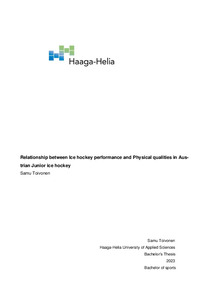Relationionship between Ice hockey performance and Physical qualities in Austrian Junior ice hockey
Toivonen, Samu (2023)
Toivonen, Samu
2023
All rights reserved. This publication is copyrighted. You may download, display and print it for Your own personal use. Commercial use is prohibited.
Julkaisun pysyvä osoite on
https://urn.fi/URN:NBN:fi:amk-202305088261
https://urn.fi/URN:NBN:fi:amk-202305088261
Tiivistelmä
This thesis studies the correlation between physical characteristics and ice hockey performance among Austrian junior players.
The research is divided into components, the first of which investigates the physical and mental demands of ice hockey. Aerobic and anaerobic performance, strength and power, speed, mobility, and mental aspects are all included.
Second component of the study focuses on junior player training methods, such as speed,
strength, and endurance. The third component of the study focuses on ice hockey physical testing. Strength and power tests, endurance tests, and speed and agility tests are all part of the process.
The fourth section of this research paper details the methods in the study. The study involved 45 players. The study's measurements included various physical test example broad jump tests sprint tests 5m-10m-5m agility test and 1500m running test. To evaluate the players' performance, they were assessed during ice hockey games, with their on-ice performance (scored points) used as an indicator of success. Statistical analysis what we used was Pearson correlation coefficient. We used that to identify any correlations between off-ice physical tests and on-ice game performance.
The results of the study showed a relationship between off-ice physical tests and on-ice game performance in U12, U14, and U16 hockey players. Results were founded in every age group.
Most significant findings were in U12 And U16 age groups in broad jump and sprint tests. These results underscore the importance of physical fitness in hockey, as well as the potential for using physical testing to predict on-ice performance. These findings have practical implications for coaches, trainers, and players looking to improve their game and reach their full potential on the ice.
The discussion section summarizes the findings and emphasizes the significance of physical attributes in ice hockey play. Additionally, it shows the limitations of the study and suggests future perspectives for research.
Overall, this thesis supplies valuable insights into the physical demands and importance of physical testing in ice hockey, effective training methods for junior players, and the importance of physical fitness in ice hockey performance. These findings have implications for coaches, trainers, and athletes looking to improve their performance in ice hockey
The research is divided into components, the first of which investigates the physical and mental demands of ice hockey. Aerobic and anaerobic performance, strength and power, speed, mobility, and mental aspects are all included.
Second component of the study focuses on junior player training methods, such as speed,
strength, and endurance. The third component of the study focuses on ice hockey physical testing. Strength and power tests, endurance tests, and speed and agility tests are all part of the process.
The fourth section of this research paper details the methods in the study. The study involved 45 players. The study's measurements included various physical test example broad jump tests sprint tests 5m-10m-5m agility test and 1500m running test. To evaluate the players' performance, they were assessed during ice hockey games, with their on-ice performance (scored points) used as an indicator of success. Statistical analysis what we used was Pearson correlation coefficient. We used that to identify any correlations between off-ice physical tests and on-ice game performance.
The results of the study showed a relationship between off-ice physical tests and on-ice game performance in U12, U14, and U16 hockey players. Results were founded in every age group.
Most significant findings were in U12 And U16 age groups in broad jump and sprint tests. These results underscore the importance of physical fitness in hockey, as well as the potential for using physical testing to predict on-ice performance. These findings have practical implications for coaches, trainers, and players looking to improve their game and reach their full potential on the ice.
The discussion section summarizes the findings and emphasizes the significance of physical attributes in ice hockey play. Additionally, it shows the limitations of the study and suggests future perspectives for research.
Overall, this thesis supplies valuable insights into the physical demands and importance of physical testing in ice hockey, effective training methods for junior players, and the importance of physical fitness in ice hockey performance. These findings have implications for coaches, trainers, and athletes looking to improve their performance in ice hockey
